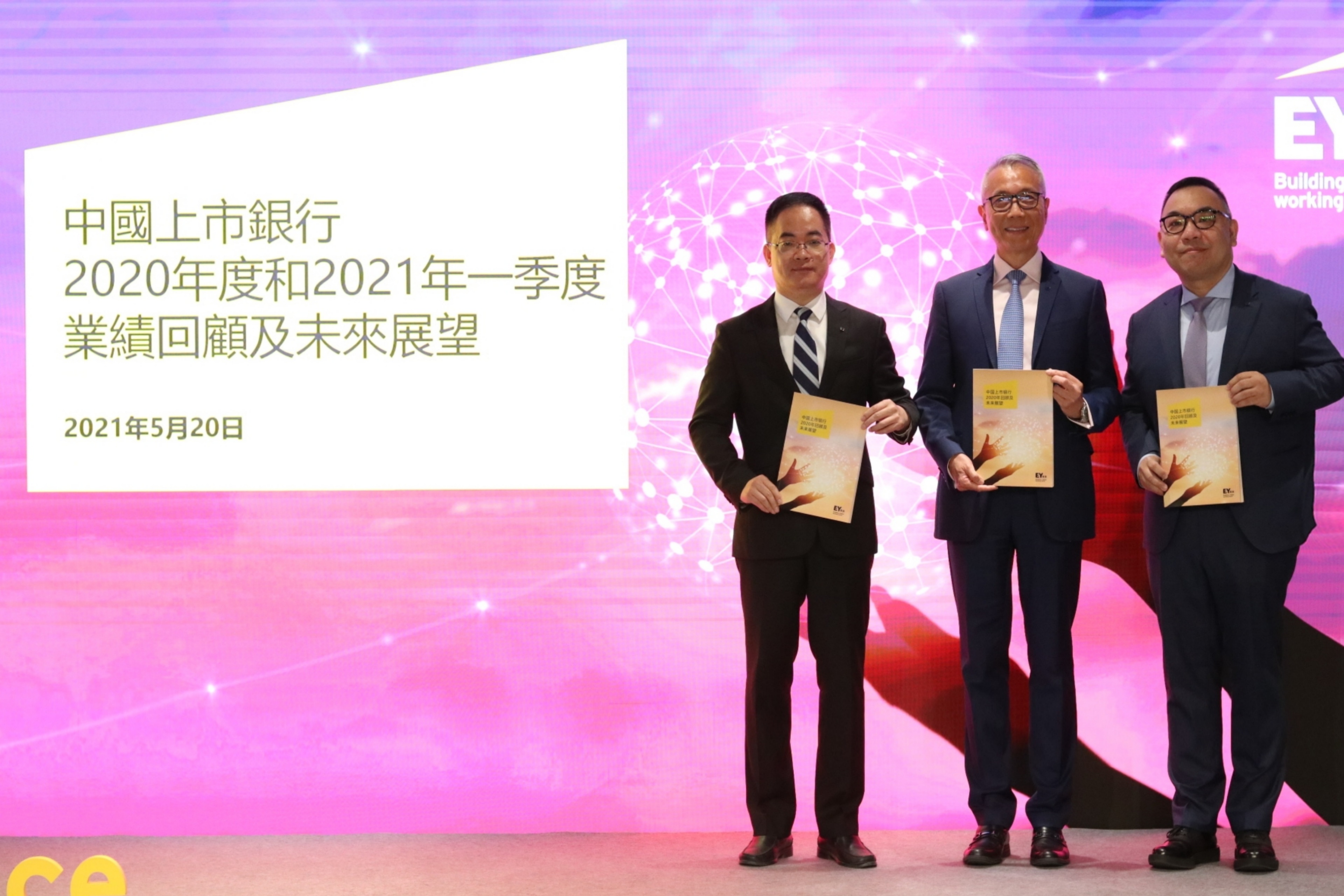EY refers to the global organization, and may refer to one or more, of the member firms of Ernst & Young Global Limited, each of which is a separate legal entity. Ernst & Young Global Limited, a UK company limited by guarantee, does not provide services to clients.
EY and IIF risk management survey shows climate change now tops both long- and short-term risk concern lists for Asia-Pacific banks
- 90% of Asia-Pacific banks’ chief risk officers (CROs) surveyed view climate change as the top emerging risk in the next five years
- Climate change, credit and cybersecurity risks are the three top issues garnering surveyed Asia-Pacific banks’ CROs’ immediate attention over the next 12 months
For the first time, climate change tops the list of both long- and short-term risks for Asia-Pacific banks, according to the 11th EY and Institute of International Finance (IIF) bank risk management survey, Resilient banking: Capturing opportunities and managing risks over the long term.
Nine in 10 (90%) Asia-Pacific bank CROs surveyed view climate change as a top long-term emerging risk over the next five years – up from 59% in 2019. While this is consistent with the global result of the survey (91%), it appears Asia-Pacific bank CROs are even more focused on climate change in the near term with 100% viewing it as a top risk, requiring their urgent attention over the next 12 months. This compares to just 49% of CROs globally who view it as a top short-term priority.
The survey of 88 financial institutions across 33 countries, including banks headquartered in Asia-Pacific, provides a window into the changes in risk management seen globally and regionally during the past decade, and examines the major risks anticipated over the next 10 years.
David Scott, EY Asia-Pacific Financial Services Risk Management Leader says: “Climate change has climbed to the top of Asia-Pacific banks’ short- and long-term risk agendas for the first time since we began this survey over a decade ago. The greater immediacy that Asia-Pacific banks’ CROs are placing on climate change risk over the next year, compared to the global average, reflects the urgency that regulators across the Asia-Pacific region have placed on climate risk management capabilities, as well as a heightened focus by investors and shareholders on disclosures.”
The survey finds that Asia-Pacific banks in practice are still maturing in their ability to assess physical and transitional risk exposures and that sourcing and managing climate risk-related data remains a challenge. While 80% of surveyed Asia-Pacific banks’ CROs report having a preliminary understanding of their climate change risk exposure, just 20% say they have a somewhat complete understanding.
Aside from climate change in the top position, not surprisingly resilience factors which have been amplified by the COVID-19 pandemic are leading the risk agenda for Asia-Pacific banks’ CROs. Cybersecurity is perceived as the second most urgent risk by CROs in the region over the next 12 months (89%), followed by credit risk linked to economic uncertainty (67%) at number three. This near-term regional priority order also differs from the global results. Globally, 98% of CROs believe credit risk will be the number-one concern for banks over the next 12 months, amid the continuing global economic recovery from the COVID-19 pandemic, with cybersecurity following at 80%.
Andrés Portilla, Managing Director, Regulatory Affairs at the IIF, says: “While cybersecurity has long been the leading immediate concern for CROs, the COVID-19 pandemic changed the game. The breadth and depth of the pandemic’s shock to the global economy has brought credit concerns to the forefront for banks over the next 12 months.”
The COVID-19 crisis also proved to be an unprecedented and unexpected test of banks’ risk management. Thankfully, for the most part, the banking sector found that its decade-long effort to build greater and higher quality capital and liquidity paid off. Greater technological resilience also came about as a result of banks accelerating their digital transformation in light of the pandemic.
Douglas Nixon, EY Asia-Pacific Banking and Capital Markets Consulting Leader says: “The COVID-19 pandemic has shown just how quickly things can change, but it’s also shown us the agility of the banking sector in times of crisis. It’s clear that banks, both regionally and globally, may have to contend with persistent and dynamic disruption not just today, but tomorrow and into the future, and it’s vital they remain resilient to all forms of risk – existing, new and emerging. Over the next decade, the crossover between talent, data and technology may be at the front of Asia-Pacific banks’ ability to survive new challenges and continue to thrive.”
Additional key survey findings include:
- While the majority of Asia-Pacific banks still see control costs increasing – primarily due to embedding greater resilience and addressing digital transformation agendas – one in ten (10%) now believe they can manage down costs of controls over the next three years by using data and technology to improve risk management.
- Five of the top 10 emerging risks according to Asia-Pacific banks’ CROs relate to technology and data, including industry disruption due to new technologies (70%), the pace and breadth of change from digitization (60%), and model risk related to machine learning / AI (50%).
- Based on lessons learned from the COVID-19 pandemic, 80% of Asia-Pacific banks’ CROs expect to see the introduction of new or additional regulatory requirements on operational resilience, and 70% of CROs expect the same on financial resilience.
- Asia-Pacific banks’ CROs expect their banks to further accelerate their digital transformation, including automating processes (78%), modernizing core technology platforms (56%) and delivering enhanced insights to customers (56%).
For more information, please visit Resilient banking: Capturing opportunities and managing risks over the long term.
-Ends-
Notes to editors
About EY
EY exists to build a better working world, helping to create long-term value for clients, people and society and build trust in the capital markets.
Enabled by data and technology, diverse EY teams in over 150 countries provide trust through assurance and help clients grow, transform and operate.
Working across assurance, consulting, law, strategy, tax and transactions, EY teams ask better questions to find new answers for the complex issues facing our world today.
EY refers to the global organization, and may refer to one or more, of the member firms of Ernst & Young Global Limited, each of which is a separate legal entity. Ernst & Young Global Limited, a UK company limited by guarantee, does not provide services to clients. Information about how EY collects and uses personal data and a description of the rights individuals have under data protection legislation are available via ey.com/privacy. EY member firms do not practice law where prohibited by local laws. For more information about our organization, please visit ey.com.
This news release has been issued by EYGM Limited, a member of the global EY organization that also does not provide any services to clients.
About the Institute of International Finance (IIF)
The Institute of International Finance (IIF) is the global association of the financial industry, with more than 450 members from more than 70 countries. Its mission is to support the financial industry in the prudent management of risks; to develop sound industry practices; and to advocate for regulatory, financial and economic policies that are in the broad interests of its members and foster global financial stability and sustainable economic growth. IIF members include commercial and investment banks, asset managers, insurance companies, sovereign wealth funds, hedge funds, central banks and development banks. To learn more about IIF, please visit www.iif.com, follow IIF on Twitter, LinkedIn or YouTube, or check out IIF’s podcasts.
About the survey
EY, in conjunction with the IIF, surveyed IIF member firms and other top banks in each region globally (including a small number of material subsidiaries that are top-five banks in their home countries) from November 2020 through January 2021. Participating banks’ CROs or other senior risk executives were interviewed, completed a survey, or both.
In total, 88 IIF member firms across 33 countries participated. Regionally, those banks were headquartered in Asia-Pacific (18%), Europe (24%), Middle East and Africa (13%), Latin America (16%) and North America (29%). Of those, 19% are globally systemically important banks (SIFIs) and 61% have been designated as systemically important domestically. Data relates to the 62 banks that completed the quantitative survey, and the narrative includes insights gleaned from qualitative interviews with some of those and other banks.
Related news
HONG KONG, 8 JULY 2021 — For the first time, climate change tops the list of both long- and short-term risks for Asia-Pacific banks, according to the 11th EY and Institute of International Finance (IIF) bank risk management survey, Resilient banking: Capturing opportunities and managing risks over the long term.
HONG KONG, 14 MAY 2024 – EY Greater China Region today released its Listed Banks in China – 2023 review and outlook report (Executive summary). The report delves into the latest changes in the operating performance, asset quality, business structure and operating model of 58 listed banks in China in 2023. It also sheds light on the transformation efforts made by these banks through a review of their development over the past five years. During this period, uncertainty has become the new normal, with profound changes in the macro environment. Despite facing a complex and turbulent business environment, listed banks have embraced and adapted to changes, sought progress while maintaining stability on the path to achieving high-quality development.
EY releases Listed banks in China – 2022 review and outlook report
HONG KONG, 16 MAY 2023 – EY Greater China region today released Listed Banks in China – 2022 review and outlook report (Executive summary), which is based on the latest changes in the operating results, asset quality, business structure, digital transformation and social responsibility efforts of 58 listed banks in China in 2022. Through reviewing their overall developments over the past five years, the report has shed light on the banks’ efforts in “focusing on the path of value creation”. Those efforts included adhering to a long-term target to create stable and reliable value for shareholders, customers and society, while building a solid safety net, improving operational efficiencies and injecting new growth momentum by strengthening risk prevention and control, deepening technology empowerment, transforming business models and employing talented teams of professionals. The report reflected EY team’s continued attention and professionalism to the Chinese banking industry.
EY releases Listed Banks in China: 2021 review and outlook
HONG KONG, 18 May 2022 — EY today released Listed banks in China – 2021 review and outlook. Covering all 59 banks listed in China, the report not only revealed how they have changed in terms of operating results, business structure, asset quality and risk resilience in 2021.
EY releases Listed Banks in China: 2020 Review and Outlook
HONG KONG, 20 May 2021 — EY released Listed Banks in China: 2020 Review and Outlook, which shows that listed banks achieved positive net profit growth in 2020, while weathering the COVID-19 pandemic with operational resilience.








